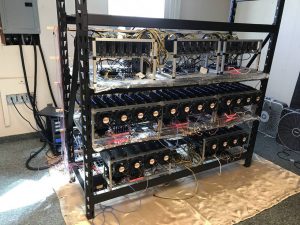
A cryptocurrency mining rig (photo courtesy of Filmar Technologies)
When Serdar Bankaci went looking for a graphics card recently, he found frustration instead.
“I personally was looking for a graphics card for gaming for myself, and I couldn’t find anything,” he said. Bankaci, president of electronics recycling company CyberCrunch, was experiencing one of the ripple effects of the cryptocurrency mining craze.
According to electronics recycling and refurbishment experts, demand for mining equipment for bitcoin and other digital currencies is affecting the industry. While unlikely to make or break an e-scrap company, rising bitcoin prices have unlocked business opportunities for hardware dealers.
‘Product flow has been really crazy’
People looking at profitably “mining,” or using computers to unlock a cryptocurrency, build or use custom computers for the task. Unlike an off-the-shelf PC, a “mining rig” can include a motherboard with multiple high-powered video cards plugged in and robust power-supply equipment.
Phil Biundo, CEO of Michigan-based IT asset disposition (ITAD) company Filmar Technologies, has found a business opportunity in the demand for that type of equipment.
When the value of bitcoin began rising dramatically last year – at the start of 2017, a bitcoin’s value was less than $1,000 and climbed to apex of $19,343 in mid-December – he started hearing requests for equipment best suited for mining. So Biundo, who has two decades of experience and contacts in the industry, started picking up the phone to buy the new components.
Earlier this month, he sent out an email listing available video cards ideal for cryptocurrency mining, with prices ranging from $410 up to $745.
“We started going around and collecting as many of the cards as we could, and basically reselling them to a lot of cryptocurrency farms,” he said. “I’ve just been capitalizing on the market. The product flow has been really crazy.”
The demand seemed to directly follow the price of bitcoin. At points, manufacturers haven’t been able to produce enough video cards to feed demand. But the price has since since fallen to less than $9,000 a coin, cooling the market for equipment, Biundo said. That being said, Filmar Technologies, a $4 million-a-year company with eight staffers, is still buying cards, waiting for the next rise in pricing.
Usually a dealer in used electronics, Biundo has seen miners searching for new video cards, he said. One reason is because of, well, other miners. They’re “overclocking” their rigs, straining the equipment. When the cards begin to fail, they sell them online. But when a buyer plugs the card into a computer and puts a load on it, that expensive part could fail. So miners tend not to seek out used cards.
Biundo is also looking at business opportunities when the price of bitcoin collapses.
Investors are assembling expensive mining farms to generate currency en masse, but if the bubble bursts or government regulation shut cryptocurrency down, that equipment will need somewhere to go, according to Biundo. He expects players in the used equipment industry will get offers to buy it. That’s why his company has discussed buying used graphics cards, testing, certifying and reselling them as markets reappear.
Spillover effects
In February, The Wall Street Journal published an article looking at how rising demand from miners for graphics cards – and the resulting steep price increases and supply shortages – is leading to some bad blood between miners and gamers.
The video game players, who have long enjoyed building machines optimized for gaming, have struggled to get their hands on graphics cards at reasonable prices.
Bankaci of Pennsylvania-based CyberCrunch ended up looking in-house and finding a refurbished one through his company.
Others are, too. One ripple effect of the mining demand is that gamers are now looking for refurbished parts. Bankaci said CyberCrunch is seeing demand from them for salvaged mid-to-higher-grade cards. “It’s not good enough for mining, but it’s still good enough for gaming,” he noted.
Selling graphics cards to miners isn’t likely to prove a goldmine for ITAD businesses. Sales of graphics cards won’t make up a huge percentage of an ITAD business’s revenue stream. Bankaci said CyberCrunch isn’t getting higher-end cards from computers retired by companies – say business-class Dell laptops, for example. They’re coming from the consumer stream, but even there, they’re hardly commonplace. Gamers generally prefer to part-out their computers, rather than recycling the whole units, Bankaci noted.
“It’s very hard to procure them as a recycler or ITAD business,” he said.



